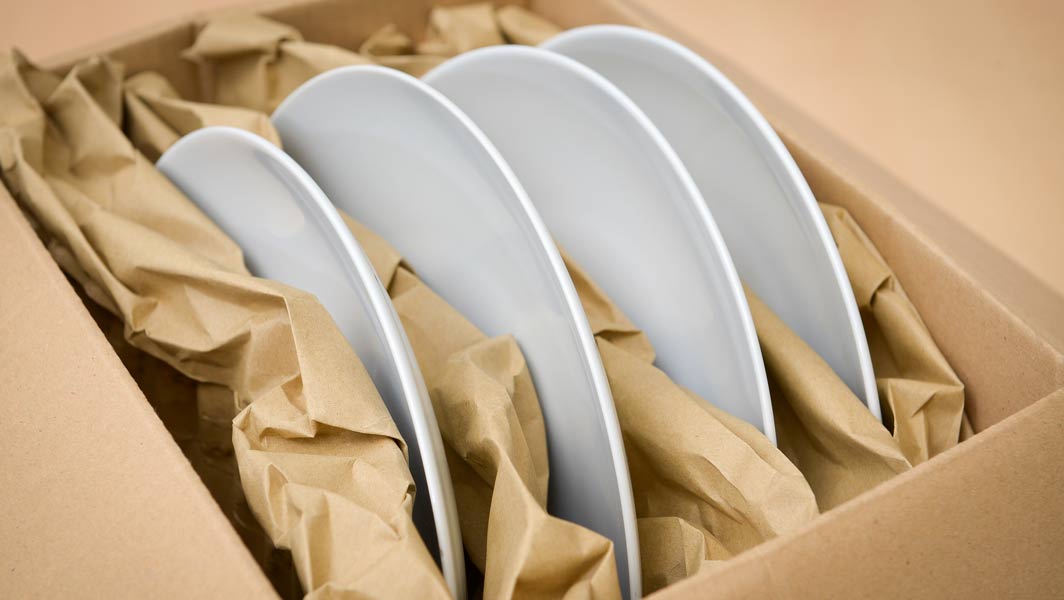THE TEST: PAPER versus PLASTIC
When we order something on the internet we all want to receive the item undamaged. The protective packaging is crucial to avoid that damage. But what is the most sustainable, protective solution: paper or plastic? Let’s have a closer look at weight, material choice, CO2 emissions and circularity. Let’s compare 100% FSC® recycled paper pads with the Pregis Renew Zero air pillow cushioning!
Which solution is going to win based on these factors:
Weight
This one is simple: the less material you use – the less impact it will have on the environment.
If you compare a volume of 1 m3 filling material for boxes. The weight of cushions filled with air is about 1/5th of the weight of paper pads. The plastic cushions exist of 99% of air, which weighs nothing. This means less material usage and less transport weight which has an additional positive effect on the environment.
CO2 emission
In this case the choice was between 100% FSC® recycled paper compared to Renew Zero plastic air cushions made of 50% post-consumer recycled content and 50% of recycled plant-based waste.
Let’s have a closer look at GHG emission during the lifecycle of these products – from the source until the cushioning material leaves the factory:
Comparing 1 kg of 100% recycled paper with 1 kg of Renew Zero fossil free plastic, Pregis Renew zero wins. The product is actually CO2 neutral. The fact that these air cushions generate zero carbon is due to the use of 50% recycled, renewable plant waste like leaves and husks – also called second generation bio sources. Trees and plants absorb CO2 or have a negative CO2 emission. This also applies to the second generation bio source in Renew Zero.
The negative CO2 emission from the 50% bio source compensates for the already low CO2 emission from the post-consumer recycled (PCR) content, resulting in a product with ZERO CO2 emissions when it leaves our factory.
Recycling
Both the paper and the plastic are 100% curbside recyclable. With good recycling programs in place in most European countries you would think they perform evenly. But we must be honest.
According to latest European figures 80% of the collected paper is recycled while plastic only 30%. This has to do with the different kinds of plastic and sorting which is often difficult, time consuming and costly. The rest of the plastic which is collected ends up in the burners and functions as fuel. Many initiatives are taken to increase this percentage or develop new recycling methods like chemical recycling – changing plastic to the original elements and create new plastic from there. So at one point in the future the balance might flip but we are not there yet.
Risk of leakage into the environment
We all bear the responsibility to correctly dispose of the product in the appropriate paper or plastic collection bins. With packages being delivered on the doorstep and opened at home the chance of actually doing this correctly is more likely than leaving the packaging material behind in nature. Should this accidentally happen, paper is compostable and will deteriorate without harm while plastic does not.
The decisive factor
The most decisive is the function of the protective material. Making sure the item you ordered is delivered on your doorstep intact is the best to do for the environment! When something arrives broken, it needs to be reproduced, reshipped etc. this has an impact on materials and CO2 emission that by far exceeds the impact of the protective packaging material. Since we're testing the most sustainable solution for void-filling and block & brace for lightweight products (up to 5 kg), AirSpeed Renew Zero is the clear winner!
Conclusion
The choice of paper or plastic depends on many factors: the product you need to ship, your shipping cycle, your goals etc. We can help you make the right choices in this respect, because the equation below does not have to be your ideal situation. When comparing FSC® recycled paper pads with Renew Zero air cushions on the factors below, Pregis Renew Zero is the winner!
|
|
100% FSC® recycled Paper cushioning |
Pregis Renew Zero Air pillow cushioning |
|
Weight |
0 |
1 |
|
CO2 emission |
0 |
1 |
|
Recycling |
1 |
0 |
|
Leakage |
1 |
0 |
|
Content protection |
0 |
1 |

